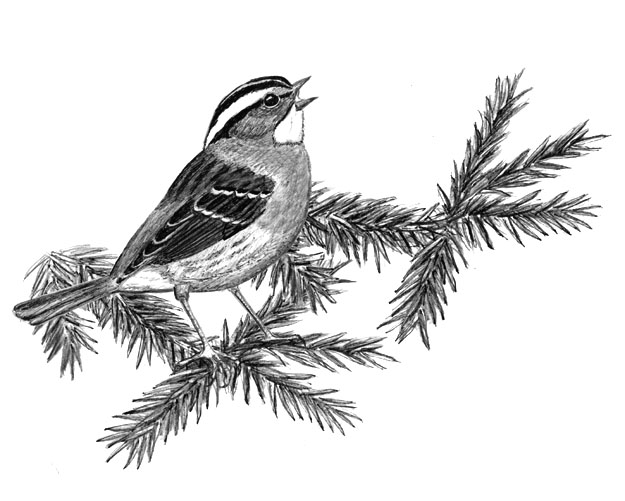
Dear Bird Folks,
I heard a distinctive bird song outside my window today. Try as I might I wasn’t able to see the bird, but I was able to record its song on my iPhone. I’ve attached a sound clip to this e-mail. Can you tell me what bird sings such a distinctive song?
– Jody, Sandwich, MA
Nice one, Jody,
I’m thrilled that you sent me that sound clip. Aren’t iPhones the best? All day long I have to listen to people, including some of my friends, tell me that smartphones are ruining society. Well, that may be true, but that’s society’s problem. My job is to ID birds and phones that can take photos and record calls are heaven-sent. Before smartphones came along I had to try to interpret bird songs based on lousy impersonations. People would come up to me and start whistling, sometimes through their false teeth or chapped lips. The sounds they produced would make dogs howl. I’d have no chance. One day a lady, who apparently was a music teacher, showed me a series of notes scribbled on a piece of paper. She wanted me to identify the birdsong based on the notes she had written. What? Me read notes? Who did she think she was talking to, Burt Bacharach? The only notes I know anything about are banknotes. Sorry, society. I’ll take an iPhone over hearing people whistle with chapped lips any day.
The sound clip you sent me is most definitely the song of a White-throated Sparrow. You were correct when you stated that this bird’s song is “distinctive.” It’s one of those iconic songs that even beginning bird watcher’s are able to remember after only hearing them once. Because White-throated Sparrows breed in the northern U.S. and in Canada, their songs are a constant part of the forests. The sound track to any summertime camping trip will include the songs of White-throated Sparrows, along with the sounds of thrushes, loons and campers swatting mosquitoes.
Learning birdcalls can be tricky, but there are a few exceptions. Some birds such as Bobwhites, whip-poor-wills and killdeer, have made things easy for us by saying their own names. Gotta love a bird like that. Other birds don’t say their names, but, if you have an imagination, you can translate their songs into easy-to-learn phrases, phrases that are in English of all things. The White-throated Sparrow is one of these birds. Its song is a series of smooth, whistled notes that sound like it’s saying, “Old Sam Peabody.” The last notes are often repeated two or three times, so the song sounds more like “Old Sam Peabody, Peabody, Peabody.” You might think a clear, simple phrase like this would be widely accepted by all birders, but Canadians want no part of Mr. Peabody. They insist that the bird is saying, “Oh sweet Canada, Canada, Canada.” That seems a little narcissistic to me. They have their name on geese, ginger ale and bacon. That’s enough.
Besides having a signature song, White-throated Sparrows also have a signature field mark. Wanna guess what it is? If you guessed they had deep blue eyes you’re way off. But if you said, “white throats” you’d be correctamundo. As their name implies, these birds have bright white throats. Because of their distinct songs and white throats, you might think White-throated Sparrows would be a snap to identify, but that’s not always the case. White-throated Sparrows have the strange habit of coming in two different color morphs. What does two color morphs mean? In addition to their white throats, some of these sparrows have gleaming white stripes on their heads, while others have dull gray/tan head stripes. Casual birders tend to think that these duller sparrows are females, but this coloring is not related to sex. However, this color morph does play an important role in breeding. For reasons that only the birds know, two different color morphs nearly always interbreed. A bird with a white stripe will only fall in love with a bird with a tan stripe. Researchers don’t know why, but some think the birds do it just to annoy racists.
White-throated Sparrows may be open-minded when it comes to breeding, but they aren’t very liberal when food is involved. They have a feeding hierarchy where dominant birds are always in charge. If a lower ranked sparrow finds food it must eat quickly before a bossier bird sees it eating, moves in and pushes it out of the way. These sparrows are masters at finding food buried beneath leaf litter. Using their power feet and claws they can easily scratch away any forest debris. The White-throated Sparrows’ superior scratching skills makes them the envy of other ground-dwelling birds…and every camper with mosquito bites.
Like most sparrows, white-throats like to nest on the ground. However, they aren’t stubborn about it. If a couple has their nest destroyed by a predator, they will promptly build a new nest, but this time they’ll build it high up in a tree for protection. Some people say that the sparrows are “smart” because they quickly learn to build their new nest off the ground. However, I say that if they were smart they wouldn’t have built their nest on the ground in the first place.
Thanks again for the sound clip, Jody. I’m so glad you have that iPhone. Smartphones may be the downfall of society, but they make my job much easier, and that’s really the important thing.